engine coolant CHEVROLET LUMINA 1993 1.G User Guide
[x] Cancel search | Manufacturer: CHEVROLET, Model Year: 1993, Model line: LUMINA, Model: CHEVROLET LUMINA 1993 1.GPages: 324, PDF Size: 17.44 MB
Page 193 of 324

Downloaded from www.Manualslib.com manuals search engine H ere you will find information
about the care of your Chevrolet
.
This part begins with service and
fuel information. and then it shows how to check important fluid and
lubricant levels
. There is also
technical information about your
vehicle. and a section devoted to its
appearance care
.
part 6
Service & Appearance Care
Service ........................................................................\
............................................. 192
Fuel
........................................................................\
.................................................. 193
Hood Release ........................................................................\
................................... 196
Engine Oil ........................................................................\
....................................... 201
Air Cleaner ........................................................................\
...................................... 205
Transaxle Fluid
........................................................................\
................................ 206
Engine Coolant
........................................................................\
................................ 211
Power Steering Fluid
........................................................................\
....................... 214
Windshield Washer Fluid
........................................................................\
................ 215
Brakes
........................................................................\
.............................................. 216
Battery
........................................................................\
............................................. 218
Bulb Replacement
........................................................................\
............................ 218
Windshield Wiper Blade Replacement
.................................................................... 224
Loading Your Vehicle
........................................................................\
...................... 224
Tires
........................................................................\
................................................. 225
Appearance Care
........................................................................\
............................. 232
Vehicle Identification Number (VIN)
.................................................................... 239
Add-on Electrical Equipment
........................................................................\
........ 240
Fuses
& Circuit Breakers ........................................................................\
............... 241
Capacities and Specifications 247
Fluids
& Lubricants ........................................................................\
........................ 249
Replacement Bulbs
........................................................................\
......................... 251
Normal Maintenance Replacement Parts
.............................................................. 254
.. ........................................................................\
..........
Page 199 of 324
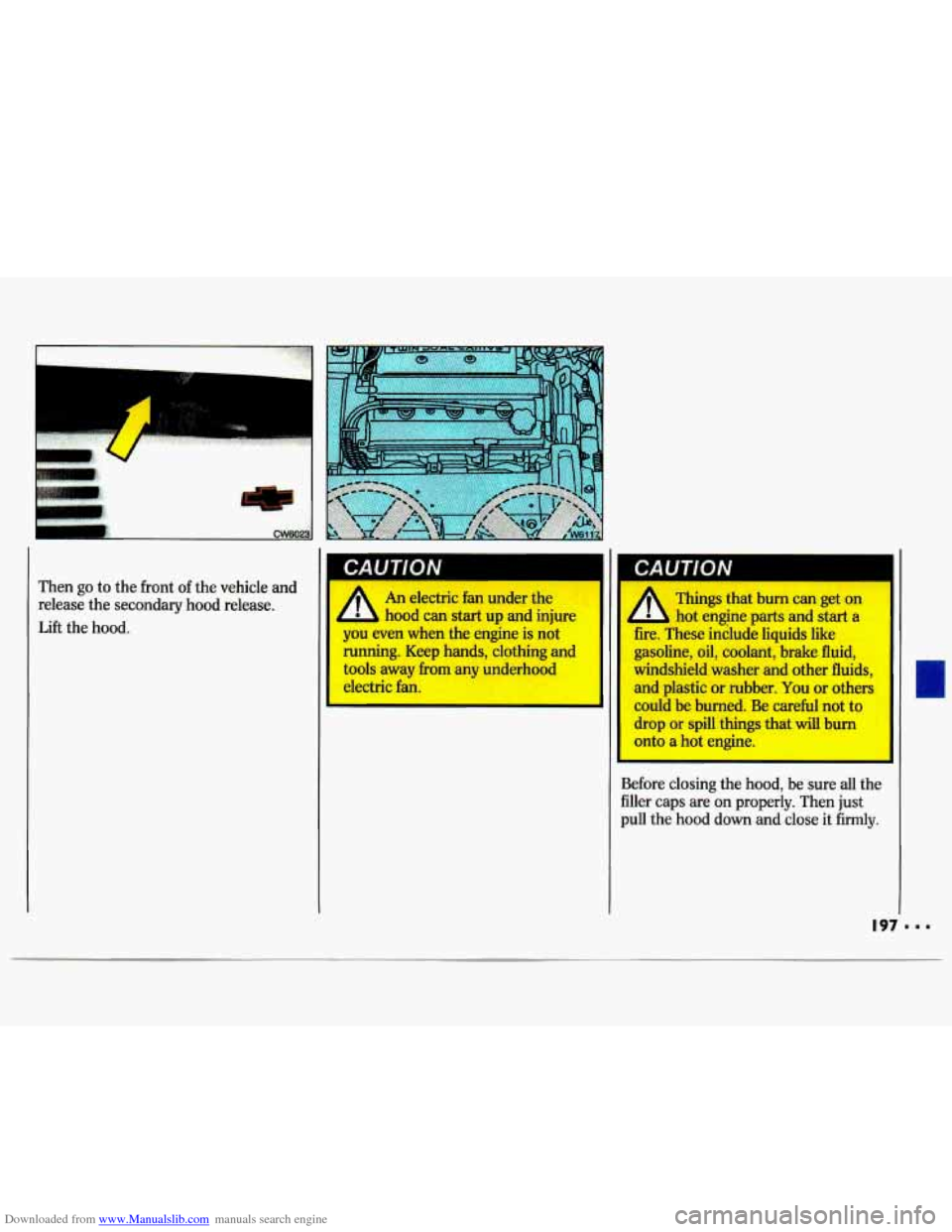
Downloaded from www.Manualslib.com manuals search engine Then go to the front of the vehicle and
release the secondary hood release.
Lift the hood.
An electric fan under the
- hood can start up and injure
you even when the engine is not
running. Keep hands, clothing and
tools away from any underhood
electric fan. A
Things that burn can get on
hot engine parts and start a
I fire. These include liquids like
gasoline, oil, coolant, brake fluid,
windshield washer and other fluids,
and plastic
or rubber. You or others
could be burned. Be careful not to
drop or spill things that will burn
onto a hot engine.
I_ ,.,,.ng be sure all the
filler caps are on properly. Then just
pull the hood down and close it firmly.
I ‘I
Page 201 of 324
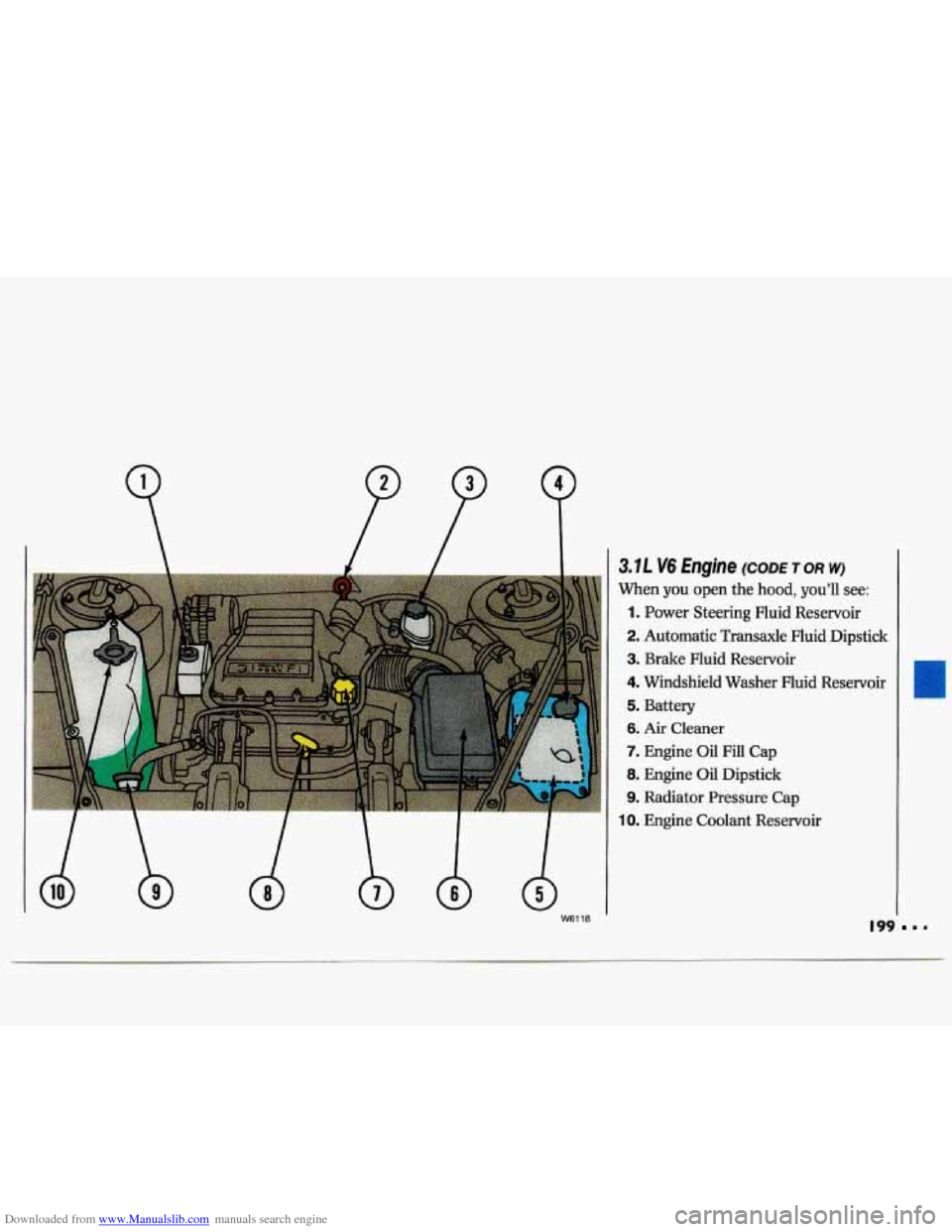
Downloaded from www.Manualslib.com manuals search engine 3.7L V6 Engine (CODE TOR w)
When you open the hood, you’ll see:
1. Power Steering Fluid Reservoir
2. Automatic Transaxle Fluid Dipstick
3. Brake Fluid Reservoir
4. Windshield Washer Fluid Reservoir
5. Battery
6. Air Cleaner
7. Engine Oil Fill Cap
8. Engine Oil Dipstick
9. Radiator Pressure Cap
10. Engine Coolant Reservoir
I99
Page 202 of 324
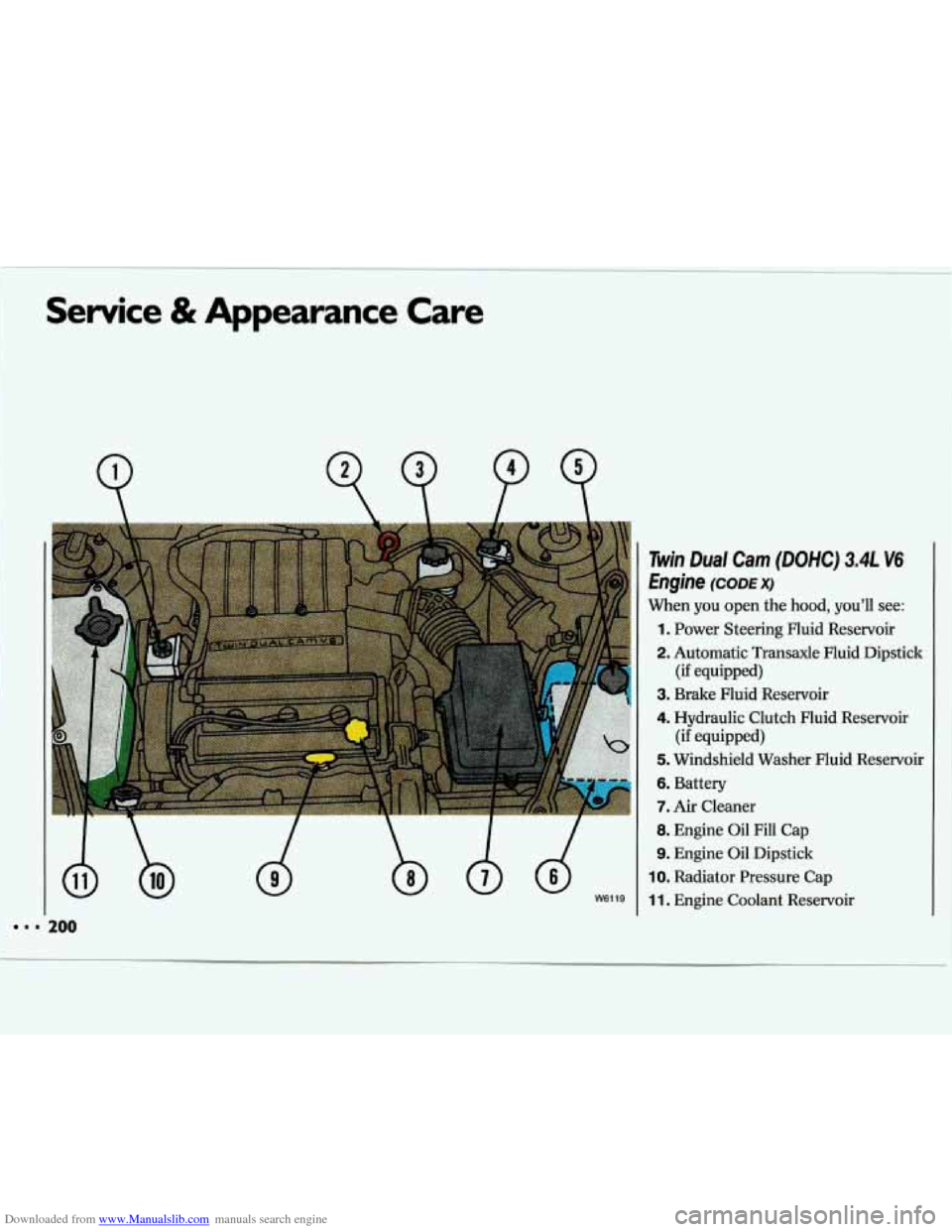
Downloaded from www.Manualslib.com manuals search engine Service & Appearance Care
= 200
W6119
Twin Dual Cam (DOHC) 3.4L V6
Engine (CODE X)
When you open the hood, you’ll see:
1. Power Steering Fluid Reservoir
2. Automatic Transaxle Fluid Dipstick
3. Brake Fluid Reservoir
4. Hydraulic Clutch Fluid Reservoir
5. Windshield Washer Fluid Reservoir
6. Battery
7. Air Cleaner
8. Engine Oil Fill Cap
9. Engine Oil Dipstick
IO. Radiator Pressure Cap
11. Engine Coolant Reservoir
(if equipped)
(if equipped)
Page 213 of 324
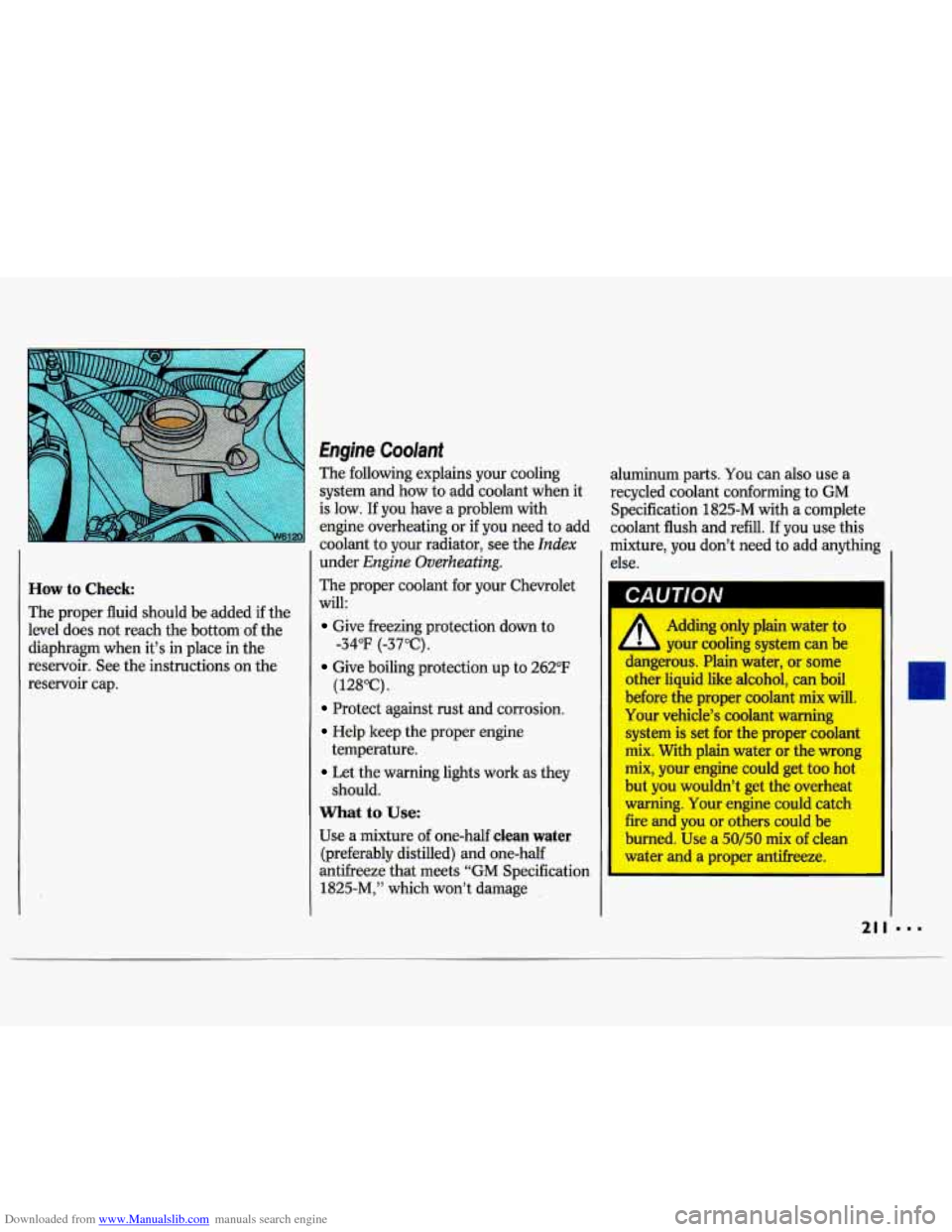
Downloaded from www.Manualslib.com manuals search engine How to Check
The proper fluid should be added if the
level does not reach the bottom of the
diaphragm when it’s
in place in the
reservoir. See the instructions on the
reservoir cap.
Engine Coolant
The following explains your cooling
system and how to add coolant when it
is low. If you have a problem with
engine overheating or
if you need to add
coolant to your radiator, see the
Index
under Engine Overheating.
The proper coolant for you1 ~ ~ ~ _et
will:
Give freezing protection c, .m to
Give boiling protection up to 262°F
Protect against rust and corrosion.
Help keep the proper engine
Let the warning lights work as they
What to Use:
Use a mixture of one-half clean water
(preferably distilled) and one-half
antifreeze that meets
“GM Specification
1825-M,” which won’t damage ,
-34°F (-37°C).
(128°C).
temperature. should. aluminum
parts. You can
also use a
recycled coolant conforming to
GM
Specification 1825-M with a complete
coolant flush and refill. If you use this
mixture, you don’t need to add anything
else.
I
9
Adding only plain water to
your cooling system can be
dangerous. Plain water, or some
other liquid like alcohol, can boil
before the proper coolant mix will.
Your vehicle’s coolant warning
system is set for the proper coolant
mix. With plain water or the wrong
mix, your engine could get too hot
but you wouldn’t get the overheat
warning. Your engine could catch fire and you or others could be
burned. Use a
50/50 mix of clean
water and a proper antifreeze.
Page 214 of 324
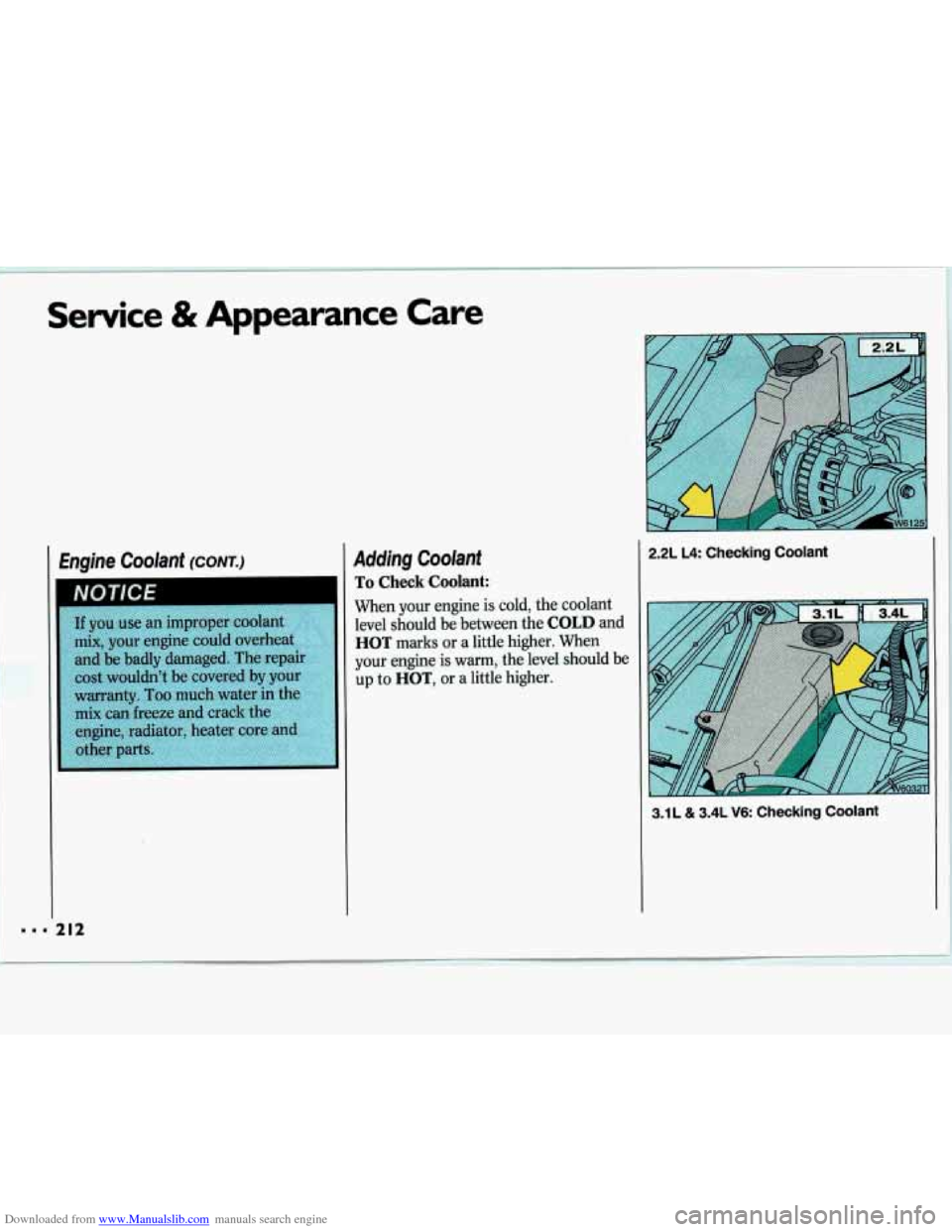
Downloaded from www.Manualslib.com manuals search engine Service & Appearance Care
Engine Coolant (CONT.)
41
Adding Coolant
To Check Coolant:
When your engine is cold, the coolant
level should be between the
COLD and
HOT marks or a little higher. When
your engine is
warm, the level should be
up to HOT, or a little higher.
2.2L L4: Checking Coolant
3.1 L & 3.4L V6: Checking Coolant
Page 215 of 324
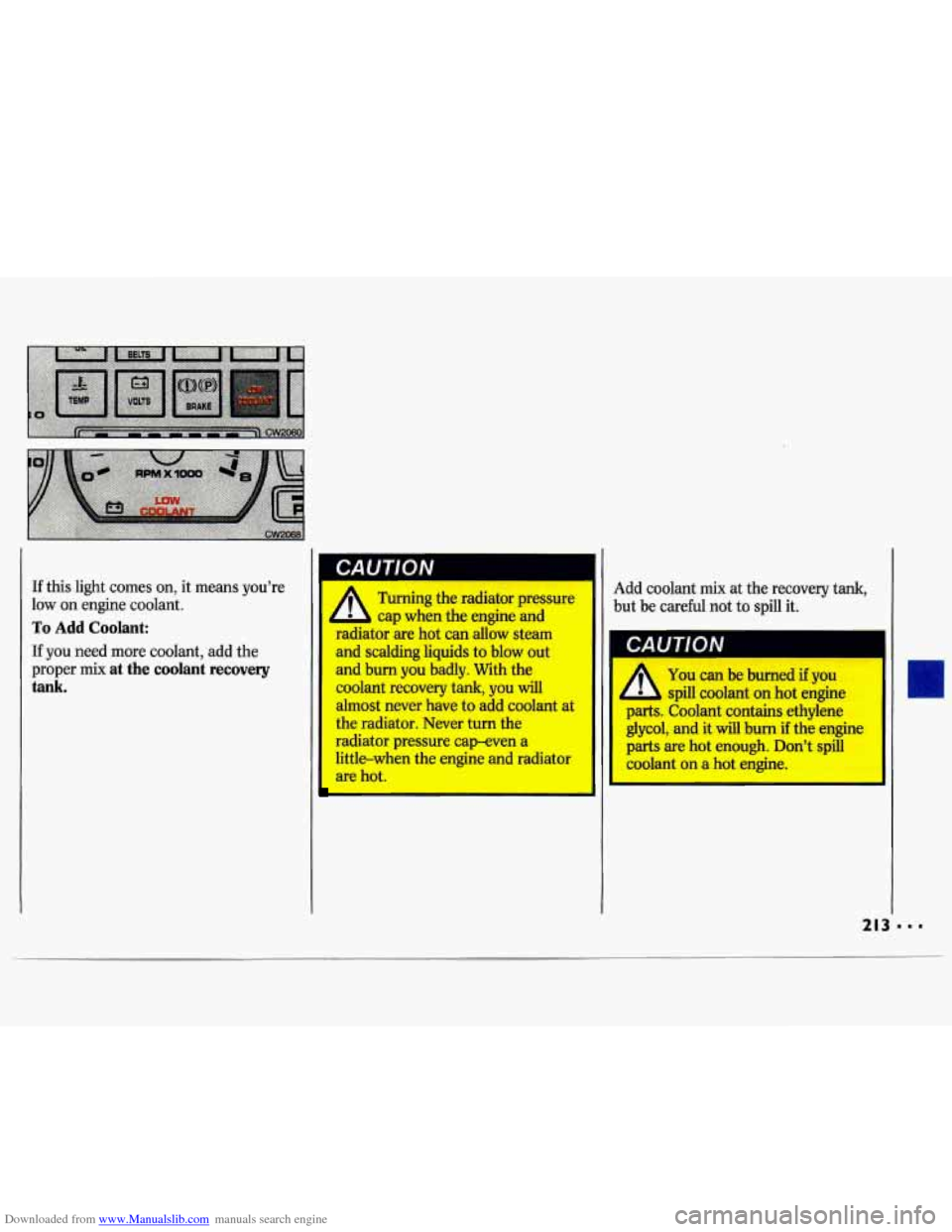
Downloaded from www.Manualslib.com manuals search engine If this light comes on, it means you’re
low on engine coolant.
To Add Coolant:
If you need more coolant, add the
proper mix
at the coolant recovery
tank.
Turning the radiator pressure
b cap when the engine and
radiator are hot can allow steam
and scalding liquids to blow out
and burn you badly. With the
coolant recovery tank, you
will
almost never have to add coolant at
the radiator. Never turn the
radiator pressure cap-even a
little-when the engine and radiator
are hot.
Add coolant mix at the recovery tank,
but be careful not to spill it.
You can be burned if you
spill coolant on hot engine
parts. Coolant contains ethylene
glycol, and it will burn
if the engine
parts are hot enough. Don’t spill
I coolant on a hot engine. I
Page 216 of 324
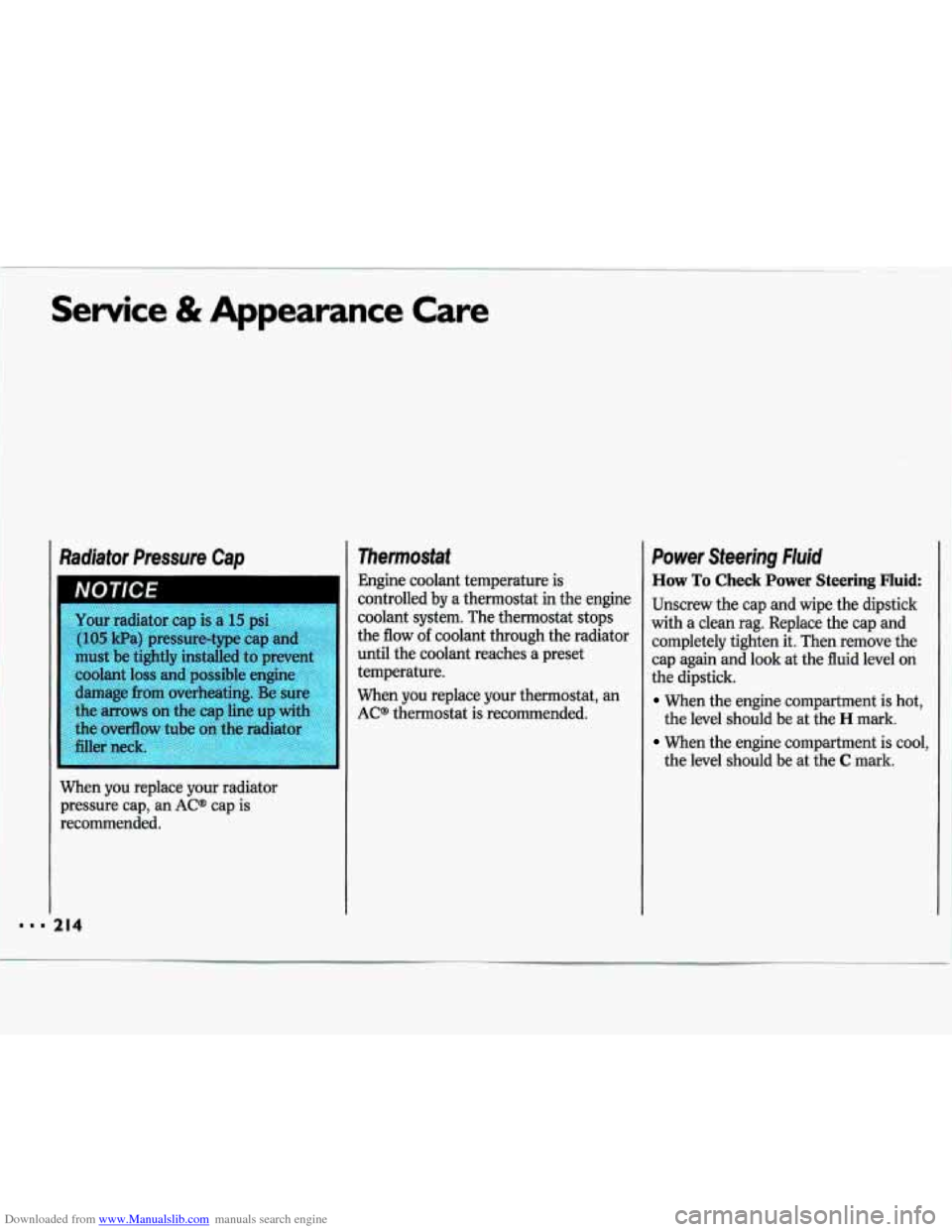
Downloaded from www.Manualslib.com manuals search engine Service & Appearance Care
Radiator Pressure Cap
214
Your radiator cap is a 15 psi
(105 Wa) pressure-type cap and
must be tightly installed to prevent
coolant loss and possible engine
damage
from overheating. Be su
the arrows on the cap line up wi
the overflow tube on the radiato
filler neck.
When you replace your radiator
pressure cap, an
AC@ cap is
recommended.
Thermostat
Engine coolant temperature is
controlled by a thermostat in the engine
coolant system. The thermostat stops
the flow
of coolant through the radiator
until the coolant reaches a preset
temperature.
When you replace your thermostat, an
AC@ thermostat is recommended.
Power Steering Fluid
How To Check Power Steering Fluid:
Unscrew the cap and wipe the dipstick
with a clean rag. Replace the cap and
completely tighten it. Then remove the
cap again and look at the fluid level
on
the dipstick.
When the engine compartment is hot,
When the engine compartment is cool,
the
level should be at the
H mark.
the level should be at the
C mark.
Page 251 of 324

Downloaded from www.Manualslib.com manuals search engine Fluids & Lubricants
ITEM
Antifreeze Coolant ...................................
Chassis Lubricant ....................................
Delco Supreme 11@ Brake Fluid .............
(Ethylene Glycol Base)
(Grease Gun Insert)
DEXROND-IIE Automatic ......................
Synchromesh Transmission Fluid ...........
GM Hydraulic Fluid ................................
Transmission Fluid
Engine Oil
................................................
GM Engine Oil Supplement ....................
(E.O.S.)
APPLICATION
Year-round antifreeze for ...........................
coolant mixtures
General chassis lube, etc.
...........................
Brake System and Clutch Master ..............
Automatic Transaxle ..................................
Cylinder
Manual Transaxle
.......................................
Clutch Master Cylinder ..............................
Engine lubrication ......................................
See your dealer for advice ..........................
GM PART NUMBER SIZE
1052753 1 gal. (3.8 L)
1052497
1052535 14 oz. (397 g)
16 02. (0.5 L)
12345881
32 oz. (1 .O L)
12345880 1 gal. (3.8 L)
12345349 32 oz. (1 .O L)
12345347 16 oz. (0.5 L)
See
the Index under Engine Oil.
1052367 16 oz. (0.5 L)
249 . .
Page 271 of 324
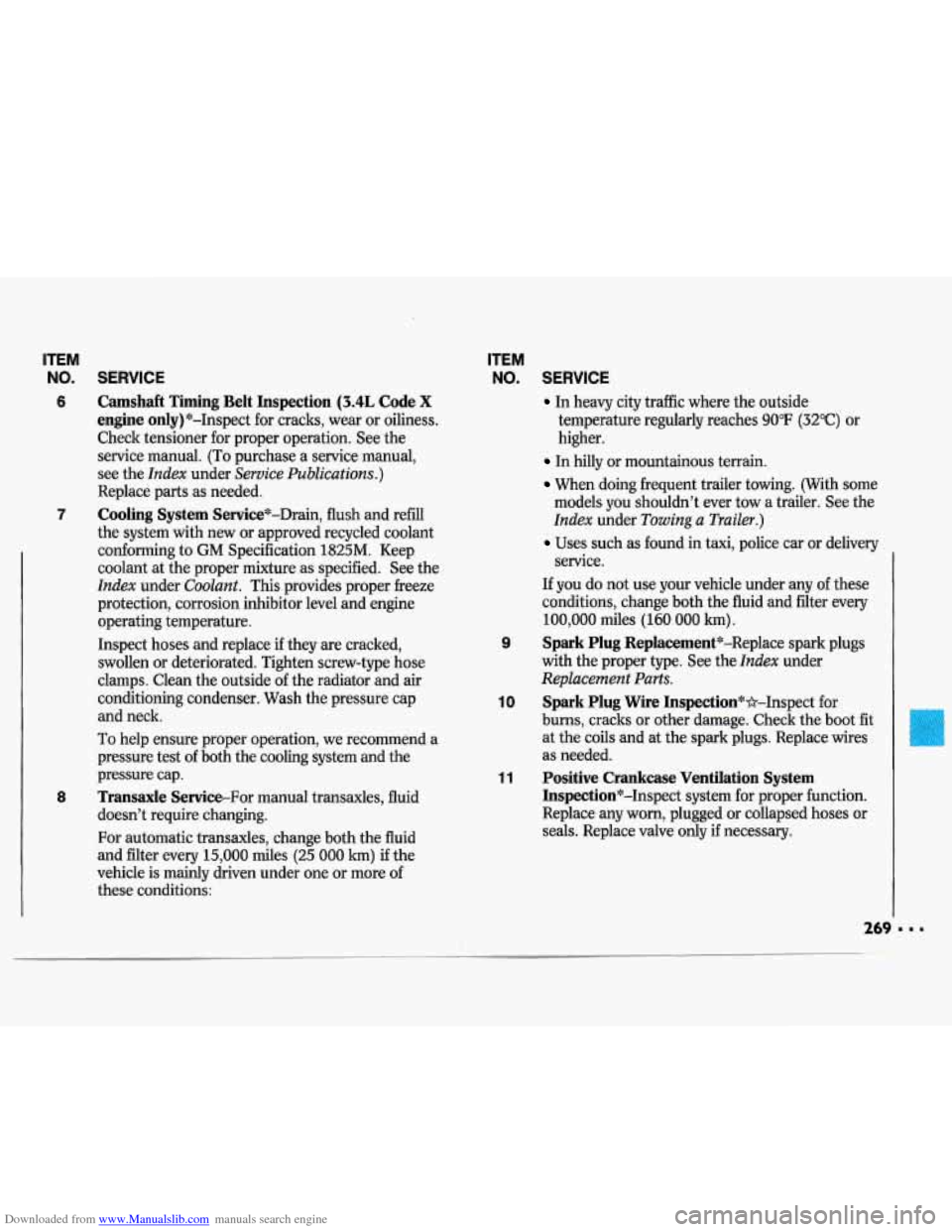
Downloaded from www.Manualslib.com manuals search engine ITEM
NO. SERVICE
6 Camshaft Timing Belt Inspection (3.4L Code X
engine only)*-Inspect for cracks, wear or oiliness.
Check tensioner for proper operation. See the
service manual.
(To purchase a service manual,
see the
Index under Service Publications.)
Replace parts as needed.
Cooling System Service*-Drain, flush and refill
the system with new or approved recycled coolant
conforming to
GM Specification 1825M. Keep
coolant at the proper mixture as specified. See the
Index under Coolant. This provides proper freeze
protection, corrosion inhibitor level and engine
operating temperature.
7
8
Inspect hoses and replace if they are cracked,
swollen or deteriorated. Tighten screw-type hose
clamps. Clean the outside of the radiator and air
conditioning condenser. Wash the pressure cap
and neck.
To help ensure proper operation, we recommend a
pressure test of both the cooling system and the
pressure cap.
Transaxle Service-For manual transaxles, fluid
doesn’t require changing.
For automatic transaxles, change both the fluid
and filter every 15,000 miles (25
000 km) if the
vehicle is mainly driven under one or more
of
these conditions:
ITEM
NO.
9
10
11
SERVICE
In heavy city traffic where the outside
temperature regularly reaches
90°F (32°C) or
higher.
In hilly or mountainous terrain.
When doing frequent trailer towing. (With some
models you shouldn’t ever tow a trailer. See the
Index under Towing a Trailer.)
Uses such as found in taxi, police car or delivery
service.
If you do not use your vehicle under any of these
conditions, change both the fluid and filter every
100,000 miles
(160 000 km).
Spark Plug Replacement*-Replace spark plugs
with the proper type. See the
Index under
Replacement Parts.
Spark Plug Wire Inspection*+Inspect for
burns, cracks
or other damage. Check the boot fit
at the coils and at the spark plugs. Replace wires
as needed.
Positive Crankcase Ventilation System
Inspection*-Inspect system for proper function.
Replace any
worn, plugged or collapsed hoses or
seals. Replace valve only if necessary.
269 .